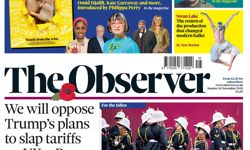If print is your business, then - plaintively, maybe even desperately - you need reasons to be cheerful. Enter Jim Moroney (pictured), publisher of the Dallas Morning News, with something to smile about.
He and his team asked 2,000 current print subscribers at what pricing point they'd stop buying a newspaper and go digital only. Then they cut and cut their bargain online offer, down to under a tenth of the monthly digital subscription. Yet still almost no-one gave up their newsprint fix.
"Hardcore news subscribers don't see digital as a substitute for print",Moroney tells conference audiences. "They won't trade down. We say in Texas that 'You are going to take this paper out of my cold, dead hand' and I don't think we should apologise for that. We should celebrate it." And there lie both hope and perplexity for publishing's future.
Future certainties, borne on a tidal wave of digital extrapolations and guru predictions, claim that the transition is inexorable, and final.
Print on paper is a fast-declining force. Print on a variety of flickering screens is what matters. But what happens if that's not quite true, not utterly inevitable, if subscribers don't see digital as their automatic "substitute" of choice?
In one sense, that would be a bleak development for everyone who cares about retaining the news-gathering financial resource that print still provides. An enfeebled print presence plus an economically anaemic digital arm (able to charge only a tenth of print for its ad content) mean efforts spread thin across a barren landscape. Hanging onto print isn't some panacea. But writing it out of the action much too fast looks pretty foolish, too. The truth of the matter, from America to Europe to right across the media world, is that the problems may seem great and over-arching - but that the answers may be individual.
Beware generalisations
Take just one of many generalisations about the newspaper market: that "young people" aren't reading papers any longer. Then turn to the National Readership Survey. The Telegraph has only 117,000 readers between 15 and 34 out of 1,311,000 all told, the Mail just 599,000 out of 4,258,000.
Could there be more menacing sets of figures, implying impending doom? But wait: the Sun has 2,410,000 young readers in its 7,007,000 universe, the Guardian 337,000 from 1,050,000, the residual Indie 187,000 from 460,000. Such age proportions between papers are utterly various.
Of course, you can average out the loss of young readers - or indeed any readers - and paint a forbidding picture of decline. But the differences matter hugely - and practically.
Print is a competitive market place, not some facile extrapolation of a steady state. There are differences between countries - look out across Europe and see France performing far better than the UK in percentage terms, or scan the globe and (on World Association of Newspapers statistics) observe newspaper readership going up, not down.
There are differences between sectors - look at magazine sales and see how some areas (dieting, yoga, women's health) can suddenly boom and defy any trend in sight. Has news analysis in magazine form had its day? Examine the corpse of Newsweek and the frail husk of Time and you might suppose so: but reach for the Economist (or indeed the Week) and the story changes wondrously.
It's ridiculous to say, because one title - say FT Deutschland - has disappeared, that "we're all doomed!". You might as well claim that the fate of MySpace means social networks are a moribund breed.
Digital and print: mutually dependent
So, if salvation isn't one thing or another but a mix of particular remedies in between, what is there worth stacking on any counter of hope?
Growing examples, I think, of where print and digital fit together rather than tug in different directions. Some are easy enough to find. Financial Times print circulation may be going down, but its digital reach is soaring behind a subscription wall. The pink paper edition remains utterly crucial: take that away and the FT has nothing to distinguish what it does from Bloomberg or Thomson-Reuters. But its content - specific, specialist, unmissable for a certain audience - turns the entire package into profitability. Could you do that without newsprint and its deadlines? Surely not, because then the FT would be an also-ran in the global data race.
Or, just as interestingly, try the same specialist pitch from a quite separate angle. You may have spotted Eric Schmidt of Google shining a spotlight on Politico the other day. Politico began six years ago when a couple of Washington Post correspondents left the paper to start again from scratch. It seemed just one madcap idea amongst many.
Who'd buy a highly specialised political news and analysis survey in print and on the net and on video in a capital where the Post still ruled? Yet, today, Politico, employing more political specialists than its rivals, is a triumphant success: making money, producing good journalism - and developing in true multi-media mode. There's the print newspaper in DC, coming out when Congress is sitting. There's a TV service of facts and interviews, a round-the-clock stream of political news and now (Schmidt's favourite) a bespoke Politico Pro operation that can charge lobbyists, government departments and the rest $8,000 or so a year for information that meets their precise requirements.
That's beginning to be very profitable now: but, then, nothing would have been possible without the newsprint version of Politico charging print advertising rates and bringing in by far the biggest early chunk of money that kept the enterprise afloat through infancy. Everything hangs together.
There's a generalisation here to note and then develop with individual degrees of caution. Politico on the net needed a print component. The most successful paywalls now mushrooming around the US benefit from just such a balanced ticket, too. The New York Times wall rose to $63 million in subscriptions last year because, in substantial part, it offered print and digital access in the same bumper bundle, majoring in particular on the strength of its Sunday edition - so that, quite beyond expectation, sales of the print Sunday paper have crept up, too. Other paywall wizards - the Post and Courier in Charleston, the Dispatch in Columbus, Ohio - use fat Sunday papers as bait for digital visitors.
There is something appealing about a deal that brings readers both dead forests and very live screens. Vitally, too, the perception that print, with a long-established cover price, is now wrapped up in a package with whatever appears on your iPad, gives a feeling of bargain time. Those thousands of readers who still liked their Dallas Morning News dropping into the mailbox have something to celebrate. They weren't ready for transition yet … if ever.
They wanted a touch of everything.
A renewed sense of purpose
In the past few months, moreover, this multi-media approach has begun to develop real momentum. Talk to newspaper managements and the rather random - nay, aimless - attitudes of a year or three back have begun to fade. Editorial staffing and costs may still be in the cutting line, but for purpose rather than as some knee-jerk reaction to the latest dire set of financial results.
If you can keep your bills under control and expand your reach, then profitability becomes more than possible again. The simple revenue streams of old - from ads, from cover price - may have grown much more various and vulnerable, but America especially has seen newspaper share prices begin to recover.
The facile thought of papers going out of business in two or three years has disappeared. To the contrary, print is seen as the stabilising part of the mix - and newspaper-like operations that exist in cyberspace alone, such as the Daily Beast, would clearly like to have a subscription wall of their own.
Even the Huffington Post can't be too far away from pondering charges. The world is just as complex a place for digital start-ups as it is for hoary old print companies.
And so, with a sudden spurt, paywalls start to grow around British newspapers as well. News International, after one of the longest pauses in Murdoch history, finally gets round to constructing its own version. The two Telegraphs join the FT in metered mode. The Times and Sunday Times adjust their rather forbidding models. Out in the regions, Local World, with Steve Auckland and David Montgomery, seek to show that putting truly local print journalists, local ad salesmen and local services together in one tight package can begin to turn things around because content - local again! - offers something unique from town to town. Montgomery says he learned a lot from his trips to Norway - and that's no blarney, because Schibsted has led Europe along new paths time again.
Warren Buffett invests in newspapers!
The point here, though, covers a multitude of bases. It's general, but also oddly specific. You can still hear the platitudes of newspapers' impending death all around: in high priced media conferences as well as in saloon bars. It's an easy equation, after all. Tablets triumph. Cyberspace rules OK. But when Warren Buffett starts buying newspapers because they're a decent investment - indeed, when the market value of paper chains in the States recovers just a hint of former glories and a new range of buyers reach for their cheque books - then something unexpected is happening.
We don't know how much a recovering American economy has to do with it, just as we don't know how far the separate languages of Europe have shielded its nations from the web surge of English content. But we do know that it's time to engage brain again. There isn't transition in any pat sense. There are currents eddying this way and that. Who put any faith in paywalls a decade ago when the tame gurus forecast disaster? Who can really be sure that today's fashionable answers will endure ten years' hence? Forget fatalism! This is a voyage of constant discovery. And we're still - somehow - alive and beginning to kick again.












